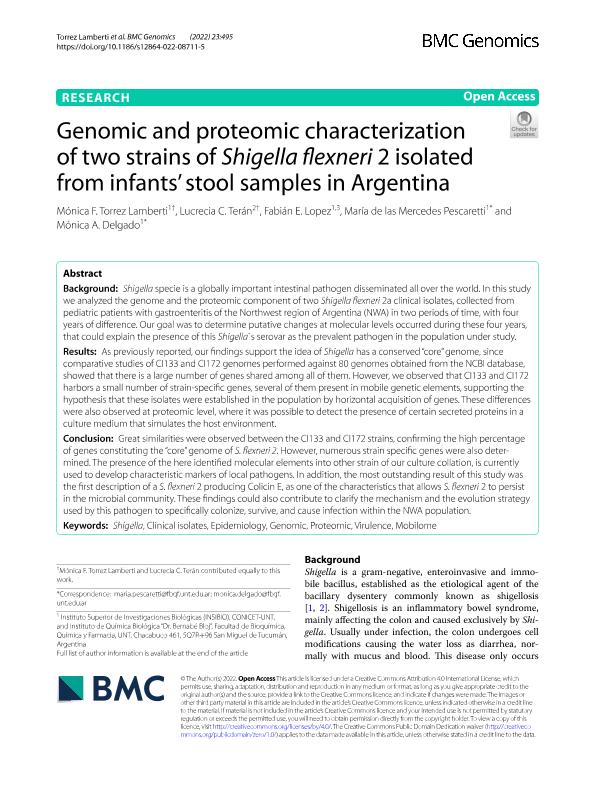Artículo
Genomic and proteomic characterization of two strains of Shigella flexneri 2 isolated from infants’ stool samples in Argentina
Torrez Lamberti, Monica Florencia ; Teran, Lucrecia Cecilia
; Teran, Lucrecia Cecilia ; Lopez, Fabian Enrique
; Lopez, Fabian Enrique ; Pescaretti, María de Las Mercedes
; Pescaretti, María de Las Mercedes ; Delgado, Monica Alejandra
; Delgado, Monica Alejandra
 ; Teran, Lucrecia Cecilia
; Teran, Lucrecia Cecilia ; Lopez, Fabian Enrique
; Lopez, Fabian Enrique ; Pescaretti, María de Las Mercedes
; Pescaretti, María de Las Mercedes ; Delgado, Monica Alejandra
; Delgado, Monica Alejandra
Fecha de publicación:
06/2022
Editorial:
BioMed Central
Revista:
BMC Genomics
ISSN:
1471-2164
Idioma:
Inglés
Tipo de recurso:
Artículo publicado
Clasificación temática:
Resumen
Background: Shigella specie is a globally important intestinal pathogen disseminated all over the world. In this study we analyzed the genome and the proteomic component of two Shigella flexneri 2a clinical isolates, collected from pediatric patients with gastroenteritis of the Northwest region of Argentina (NWA) in two periods of time, with four years of difference. Our goal was to determine putative changes at molecular levels occurred during these four years, that could explain the presence of this Shigella`s serovar as the prevalent pathogen in the population under study. Results: As previously reported, our findings support the idea of Shigella has a conserved “core” genome, since comparative studies of CI133 and CI172 genomes performed against 80 genomes obtained from the NCBI database, showed that there is a large number of genes shared among all of them. However, we observed that CI133 and CI172 harbors a small number of strain-specific genes, several of them present in mobile genetic elements, supporting the hypothesis that these isolates were established in the population by horizontal acquisition of genes. These differences were also observed at proteomic level, where it was possible to detect the presence of certain secreted proteins in a culture medium that simulates the host environment. Conclusion: Great similarities were observed between the CI133 and CI172 strains, confirming the high percentage of genes constituting the “core” genome of S. flexneri 2. However, numerous strain specific genes were also determined. The presence of the here identified molecular elements into other strain of our culture collation, is currently used to develop characteristic markers of local pathogens. In addition, the most outstanding result of this study was the first description of a S. flexneri 2 producing Colicin E, as one of the characteristics that allows S. flexneri 2 to persist in the microbial community. These findings could also contribute to clarify the mechanism and the evolution strategy used by this pathogen to specifically colonize, survive, and cause infection within the NWA population.
Palabras clave:
CLINICAL ISOLATES
,
EPIDEMIOLOGY
,
GENOMIC
,
MOBILOME
,
PROTEOMIC
,
SHIGELLA
,
VIRULENCE
Archivos asociados
Licencia
Identificadores
Colecciones
Articulos(CERELA)
Articulos de CENTRO DE REFERENCIA PARA LACTOBACILOS (I)
Articulos de CENTRO DE REFERENCIA PARA LACTOBACILOS (I)
Articulos(INSIBIO)
Articulos de INST.SUP.DE INVEST.BIOLOGICAS
Articulos de INST.SUP.DE INVEST.BIOLOGICAS
Citación
Torrez Lamberti, Monica Florencia; Teran, Lucrecia Cecilia; Lopez, Fabian Enrique; Pescaretti, María de Las Mercedes; Delgado, Monica Alejandra; Genomic and proteomic characterization of two strains of Shigella flexneri 2 isolated from infants’ stool samples in Argentina; BioMed Central; BMC Genomics; 23; 1; 6-2022; 1-26
Compartir
Altmétricas



